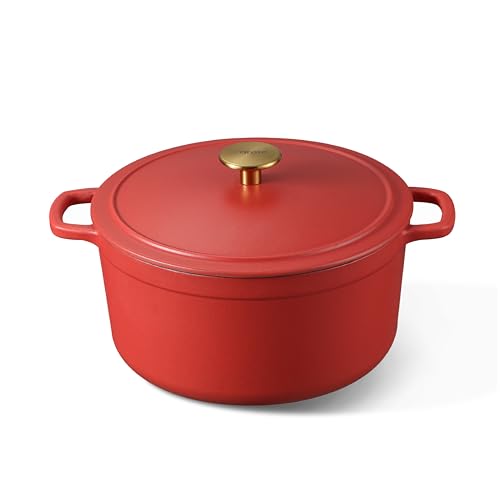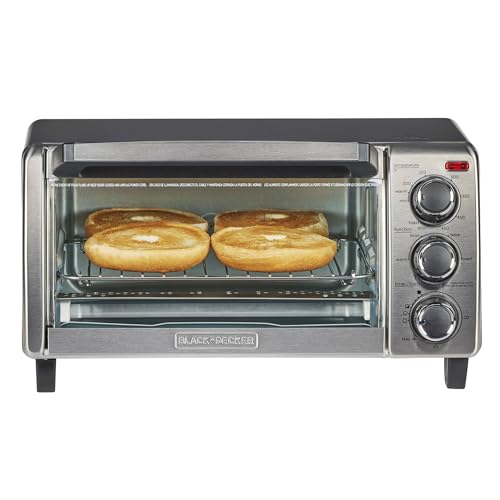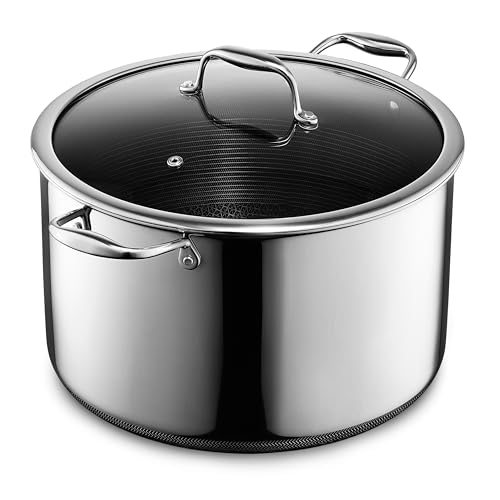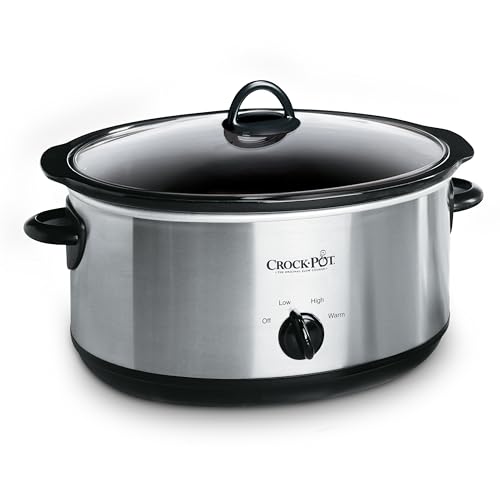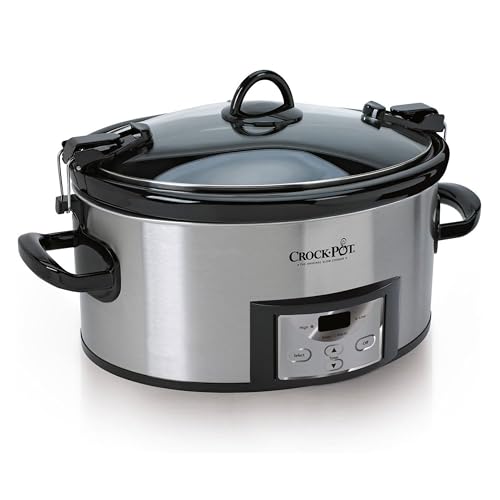Ingredients
This homemade chicken noodle soup requires simple pantry staples and fresh ingredients that work together to create maximum flavor. You’ll need ingredients for four components: the chicken, soup base, vegetables, and noodles.
For the Chicken
- 2 pounds bone-in chicken thighs with skin
- 1 pound boneless chicken breasts
- 1 teaspoon kosher salt
- 1/2 teaspoon black pepper
- 2 tablespoons olive oil
For the Soup Base
- 10 cups low-sodium chicken broth
- 2 cups water
- 2 bay leaves
- 1 teaspoon dried thyme
- 1/2 teaspoon dried rosemary
- 1 teaspoon garlic powder
- Salt and pepper to taste
For the Vegetables
- 3 large carrots, peeled and sliced into 1/4-inch rounds
- 3 celery stalks, chopped into 1/2-inch pieces
- 1 large yellow onion, diced
- 3 garlic cloves, minced
- 2 tablespoons fresh parsley, chopped
- 2 tablespoons butter
For the Noodles
- 8 ounces wide egg noodles
- 1 tablespoon salt for pasta water
- 2 tablespoons olive oil to prevent sticking
Equipment Needed
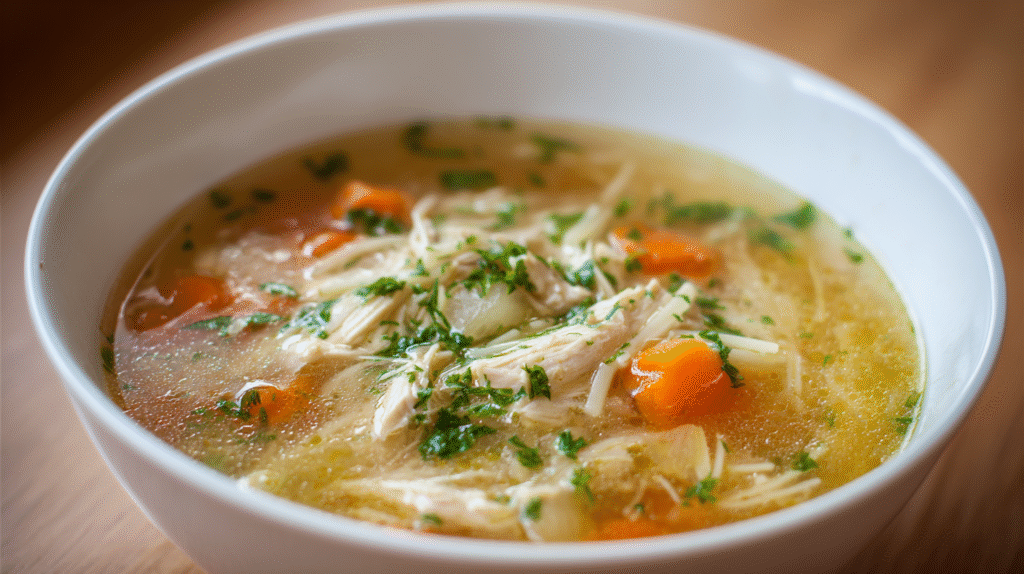
You’ll need a large Dutch oven or heavy-bottomed stockpot to create this hearty chicken noodle soup. The vessel should hold at least 6 quarts to accommodate all ingredients comfortably and allow proper simmering space. A good cutting board provides your workspace for chopping vegetables and shredding chicken. Sharp kitchen knives make prep work efficient and safe.
Your measuring cups and spoons ensure accurate ingredient proportions for consistent results. A wooden spoon works best for stirring without scratching your pot’s surface. Tongs help you remove chicken pieces from hot broth safely. A fine-mesh strainer removes any impurities from your finished broth.
A ladle serves the soup perfectly into bowls while controlling portion sizes. Small prep bowls keep your chopped vegetables organized and ready for cooking. A meat thermometer verifies your chicken reaches safe internal temperatures during cooking.
| Equipment | Size/Type | Purpose |
|---|---|---|
| Dutch oven or stockpot | 6+ quarts | Main cooking vessel |
| Cutting board | Large | Vegetable and chicken prep |
| Chef’s knife | 8-10 inch | Chopping ingredients |
| Measuring cups | Various sizes | Accurate measurements |
| Wooden spoon | Standard | Stirring without scratching |
| Tongs | Medium | Safe chicken handling |
| Fine-mesh strainer | Standard | Broth clarification |
| Ladle | Large | Serving portions |
Most home kitchens already contain these basic tools. Quality equipment makes the cooking process smoother and more enjoyable. Your investment in good cookware pays off with better heat distribution and longer-lasting performance.
Instructions
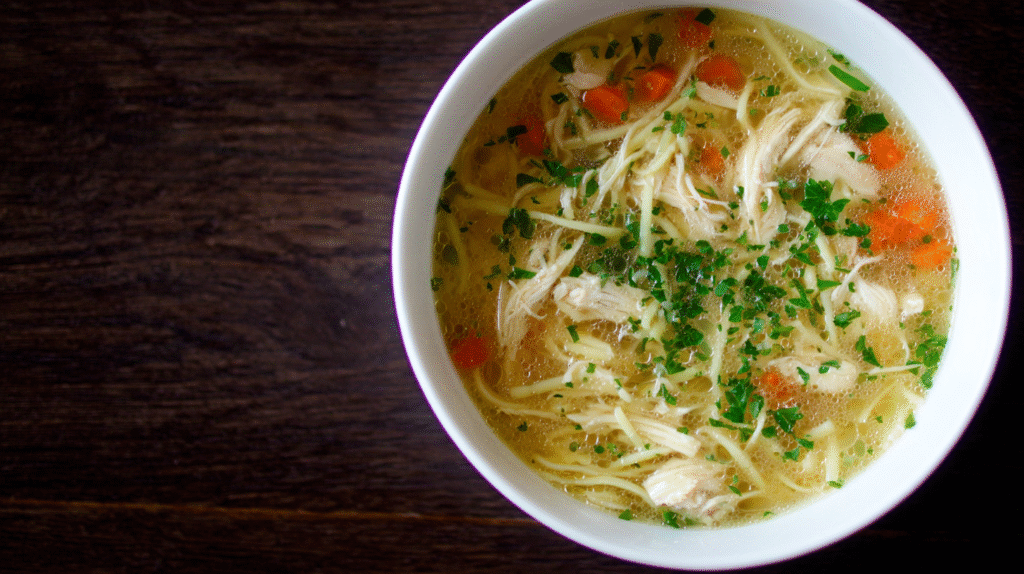
Follow these step-by-step instructions to create your perfect chicken noodle soup from scratch. Each phase builds upon the previous one to develop rich flavors and tender textures.
Prep the Chicken
Pat both the bone-in chicken thighs and boneless chicken breasts completely dry with paper towels. Season all pieces generously with salt and black pepper on both sides. Allow the chicken to rest at room temperature for 15 minutes while you prepare your vegetables. This resting period ensures even cooking and better flavor absorption.
Cook the Chicken
Heat 2 tablespoons of olive oil in your Dutch oven over medium-high heat until shimmering. Add the seasoned chicken thighs skin-side down first and cook for 5-6 minutes until golden brown. Flip the thighs and add the chicken breasts to the pot. Cook both types of chicken for another 4-5 minutes until the breasts are golden on one side. Remove all chicken pieces to a plate and set aside. The chicken will finish cooking in the broth later.
Prepare the Vegetables
Reduce heat to medium and add diced onions to the same pot with the chicken drippings. Sauté for 3-4 minutes until softened and translucent. Add the diced carrots and celery to the pot and cook for another 3 minutes until slightly softened. Stir in minced garlic and cook for 30 seconds until fragrant. The vegetables should retain some bite since they will continue cooking in the broth.
Make the Soup Base
Pour the chicken broth into the pot and scrape up any browned bits from the bottom using your wooden spoon. Add the bay leaves, dried thyme, and parsley stems if using. Return all chicken pieces to the pot ensuring they are mostly submerged in liquid. Bring the mixture to a boil then reduce heat to low and simmer partially covered for 25-30 minutes until chicken is fully cooked and tender.
Cook the Noodles
Remove the cooked chicken from the pot and set aside to cool slightly. Strain out and discard the bay leaves. Bring the soup base back to a rolling boil and add the wide egg noodles. Cook the noodles according to package directions minus 1 minute since they will continue cooking in the hot broth. Meanwhile, shred the cooled chicken into bite-sized pieces and discard the bones and skin.
Assemble the Soup
Return the shredded chicken to the pot with the cooked noodles. Stir in the fresh chopped parsley and season with additional salt and pepper to taste. Ladle the hot soup into bowls and serve immediately while the noodles maintain their perfect texture. Garnish with extra fresh herbs if desired.
Cooking Tips and Tricks
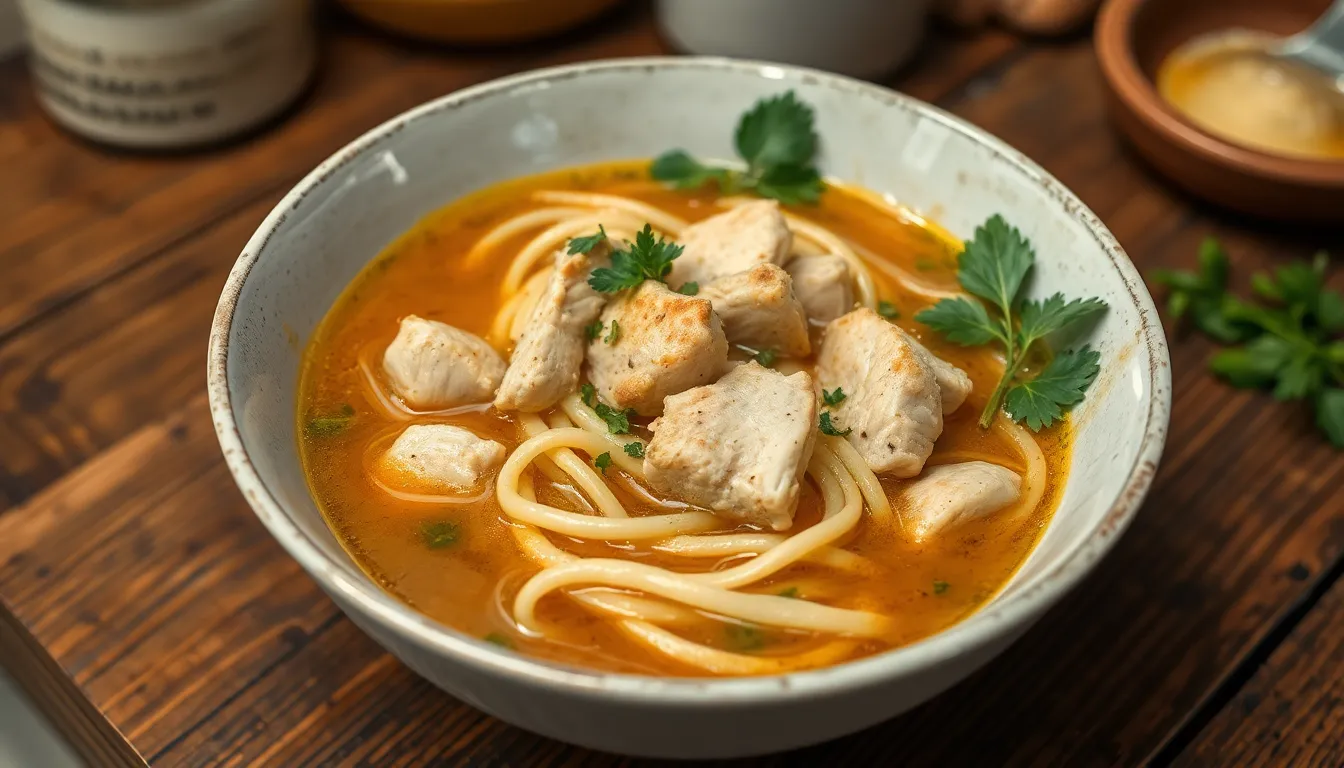
Master these essential techniques to elevate your chicken noodle soup from good to extraordinary. These professional methods ensure consistent results every time you make this beloved comfort food.
How to Keep Noodles from Getting Mushy
Cook your noodles separately in salted boiling water until they reach al dente texture. Drain them immediately and rinse with cold water to stop the cooking process. Add the cooked noodles to individual serving bowls rather than the entire pot of soup.
Store leftover soup and noodles in separate containers to prevent the pasta from absorbing excess liquid overnight. When reheating leftovers you can add the noodles back to the soup just before serving. This method preserves the noodles’ ideal texture and prevents them from becoming soggy.
Consider using heartier pasta shapes like rotini or penne if you plan to store the soup with noodles included. These shapes hold their structure better than traditional egg noodles during extended cooking and storage periods.
Best Chicken Cuts to Use
Dark meat provides superior flavor and moisture retention throughout the long cooking process. Bone-in chicken thighs deliver the richest taste while remaining tender even after extended simmering. The bones release gelatin that creates a naturally thick and satisfying broth.
Chicken breasts work well when combined with thighs but avoid using them alone as they can become dry and stringy. Remove breast meat earlier in the cooking process to prevent overcooking while allowing thighs to continue simmering.
Whole chickens offer the most economical option and provide both white and dark meat variety. Cut the whole bird into pieces before cooking to ensure even heat distribution and easier handling during the shredding process.
Seasoning Adjustments
Taste your soup multiple times during cooking and adjust seasonings gradually. Salt levels should build throughout the cooking process rather than being added all at once. Remember that the broth will concentrate as it simmers so start with less seasoning than you think you need.
Fresh herbs added at the end of cooking provide bright flavor that dried herbs cannot match. Reserve half of your fresh parsley or dill to stir in just before serving. Bay leaves should be removed before serving to prevent accidental consumption.
Black pepper loses potency during long cooking times so add it in two stages. Use half the amount during cooking and finish with freshly cracked pepper just before serving. Lemon juice brightened the overall flavor profile when added at the very end of cooking.
Make-Ahead Instructions
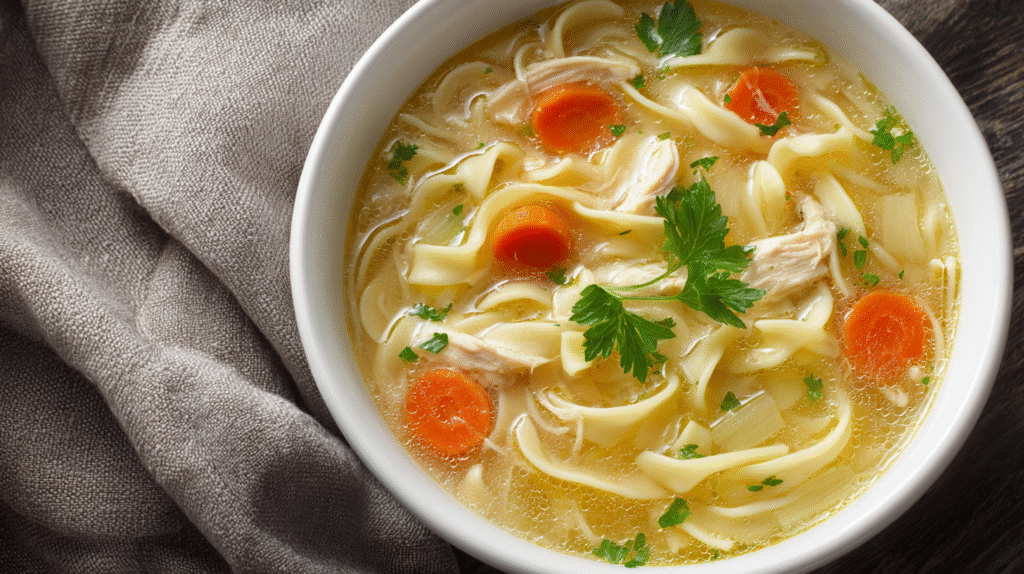
Preparing chicken noodle soup ahead of time saves you precious hours during busy weekdays while maintaining the same comforting flavors you crave. You can complete most of the soup preparation up to three days in advance by following these strategic make-ahead steps.
Cook the chicken and vegetables completely through step four of the main recipe. Allow the soup base to cool completely before transferring it to refrigerator-safe containers. Store the cooled soup base in the refrigerator for up to three days or freeze it for up to three months.
Prepare the noodles separately when you’re ready to serve rather than cooking them with the soup base. Fresh noodles maintain their perfect texture when cooked just before serving instead of sitting in the broth for extended periods.
Reheat the refrigerated soup base in your Dutch oven over medium heat until it reaches a gentle simmer. Add the fresh noodles directly to the reheated soup and cook according to package directions. This method prevents the noodles from becoming mushy and maintains the soup’s restaurant-quality texture.
Freeze individual portions in freezer-safe containers for quick single servings. Leave about one inch of headspace in each container to allow for expansion during freezing. Thaw frozen soup overnight in the refrigerator before reheating.
Season the soup after reheating since flavors can diminish during storage. Taste and adjust salt, pepper, and herbs as needed. Fresh parsley or dill added just before serving brightens the flavors and provides that just-made appearance.
Store the soup base and noodles in separate containers when meal prepping for the week. This separation technique ensures optimal texture and prevents the noodles from absorbing too much broth during storage.
Storage and Reheating
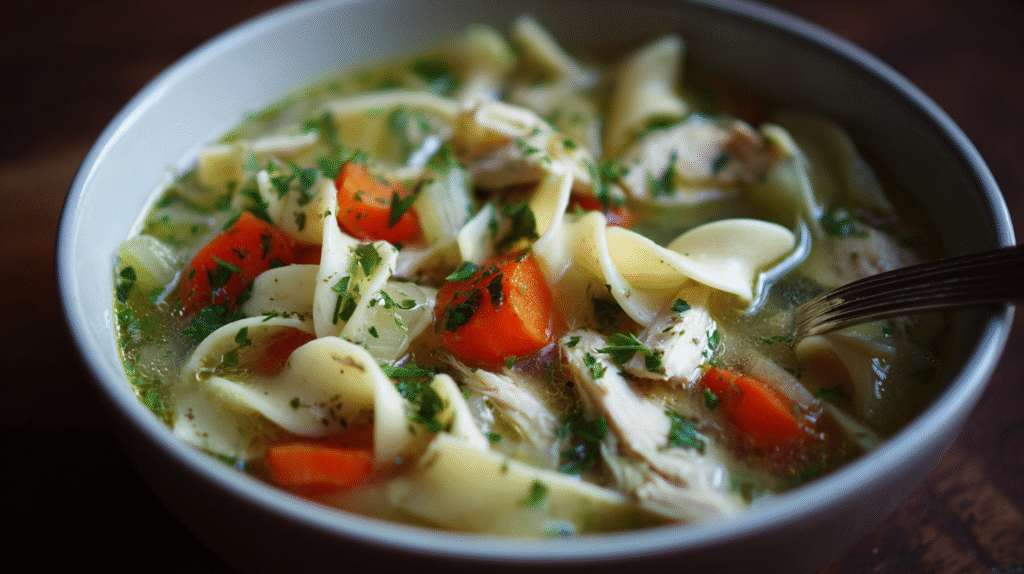
Proper storage techniques help maintain your chicken noodle soup’s quality and flavor for days to come. Following these guidelines ensures food safety while preserving the soup’s comforting taste.
Refrigerator Storage
Store your cooled chicken noodle soup in airtight containers within two hours of cooking. The soup base keeps fresh in the refrigerator for up to 4 days when stored properly. Keep noodles and soup base in separate containers to prevent the noodles from absorbing excess liquid and becoming mushy.
Label containers with the preparation date to track freshness. Glass containers work best for storing soup as they don’t absorb flavors or odors. Fill containers leaving about an inch of headspace to allow for expansion when the soup cools completely.
Remove any visible fat layer that forms on the surface before reheating for better texture and taste. Your leftover soup maintains optimal quality when refrigerated at 40°F or below consistently.
Freezer Storage
Freeze chicken noodle soup base without noodles for up to 3 months in freezer-safe containers or heavy-duty freezer bags. Cool the soup completely before freezing to prevent ice crystals from forming and affecting texture.
Portion the soup into meal-sized containers for convenient thawing and reheating. Leave extra space in containers as liquids expand when frozen. Flat freezer bags save space and thaw more quickly than containers.
Write the contents and date clearly on each container or bag. Avoid freezing soup with noodles already added since pasta becomes mushy after freezing and thawing. Cook fresh noodles when ready to serve the thawed soup base.
Reheating Instructions
Thaw frozen soup overnight in the refrigerator before reheating for even warming. Heat refrigerated soup gently over medium-low heat while stirring occasionally to prevent sticking or scorching.
Bring the soup to a rolling boil for food safety then reduce heat to maintain a gentle simmer. Taste and adjust seasonings after reheating since flavors can diminish during storage. Add fresh herbs during the last few minutes of reheating for bright flavor.
Cook fresh noodles separately and add them to individual bowls before ladling the hot soup over them. This method prevents overcooking and maintains the noodles’ ideal texture. Heat only the amount you plan to serve immediately for best results.
Microwave individual portions in microwave-safe bowls covered with a microwave-safe plate. Heat in 1-minute intervals while stirring between each interval until thoroughly heated. Add a splash of chicken broth if the soup appears too thick after reheating.
Recipe Variations
Transform your classic chicken noodle soup into different versions that suit your cooking preferences and dietary needs. These adaptations maintain the comforting essence while offering convenient alternatives.
Slow Cooker Version
Place seasoned chicken thighs and breasts in your slow cooker with diced onions, carrots, and celery. Pour low-sodium chicken broth over the ingredients and add bay leaves, thyme, and salt. Cook on low for 6-8 hours or high for 3-4 hours until chicken shreds easily with a fork.
Remove chicken from the slow cooker and shred into bite-sized pieces using two forks. Strain the cooking liquid through a fine-mesh strainer to remove vegetable solids and return the clear broth to the slow cooker. Add fresh diced vegetables back to the pot for better texture and color.
Cook egg noodles separately according to package directions while the soup finishes. Return shredded chicken to the slow cooker and season with salt and pepper to taste. Serve hot soup over cooked noodles in individual bowls and garnish with fresh parsley or dill.
Instant Pot Version
Set your Instant Pot to sauté mode and brown seasoned chicken pieces in olive oil for 3-4 minutes per side. Add diced onions, carrots, and celery to the pot and cook for 2-3 minutes until fragrant. Pour chicken broth into the pot and scrape up any browned bits from the bottom.
Add bay leaves, thyme, salt, and pepper to the mixture before securing the Instant Pot lid. Set the pressure cooker to high pressure for 15 minutes with natural pressure release for 10 minutes. Quick release any remaining pressure before carefully opening the lid.
Remove chicken from the pot and shred into pieces while the broth stays warm. Cook noodles separately in boiling salted water according to package directions. Return shredded chicken to the Instant Pot and adjust seasonings before serving over freshly cooked noodles.
Gluten-Free Option
Replace traditional wheat-based egg noodles with gluten-free alternatives like rice noodles, quinoa pasta, or chickpea noodles. Cook these alternatives according to their exact package directions since cooking times vary significantly between different gluten-free pasta types.
Check that your chicken broth is certified gluten-free as some commercial broths contain wheat-based thickeners. Use cornstarch mixed with cold water instead of flour if you need to thicken the soup base. Add the cornstarch slurry during the last few minutes of cooking while stirring constantly.
Consider adding extra vegetables like diced potatoes, parsnips, or zucchini to create more substance without relying on traditional noodles. These vegetables absorb the flavorful broth while providing satisfying texture and nutritional value to your gluten-free chicken soup.
Conclusion
You’ve now got everything you need to create the perfect bowl of chicken noodle soup from scratch. This recipe delivers restaurant-quality results using simple ingredients you likely already have in your kitchen.
Whether you’re battling a cold or simply craving comfort food your homemade soup will fill your home with amazing aromas and warm your soul. The flexibility of this recipe means you can adapt it to your dietary needs or cooking schedule.
Don’t forget to cook your noodles separately and store leftovers properly to maintain that perfect texture. With these techniques in your arsenal you’ll be making memorable bowls of chicken noodle soup that’ll become a family favorite for years to come.








